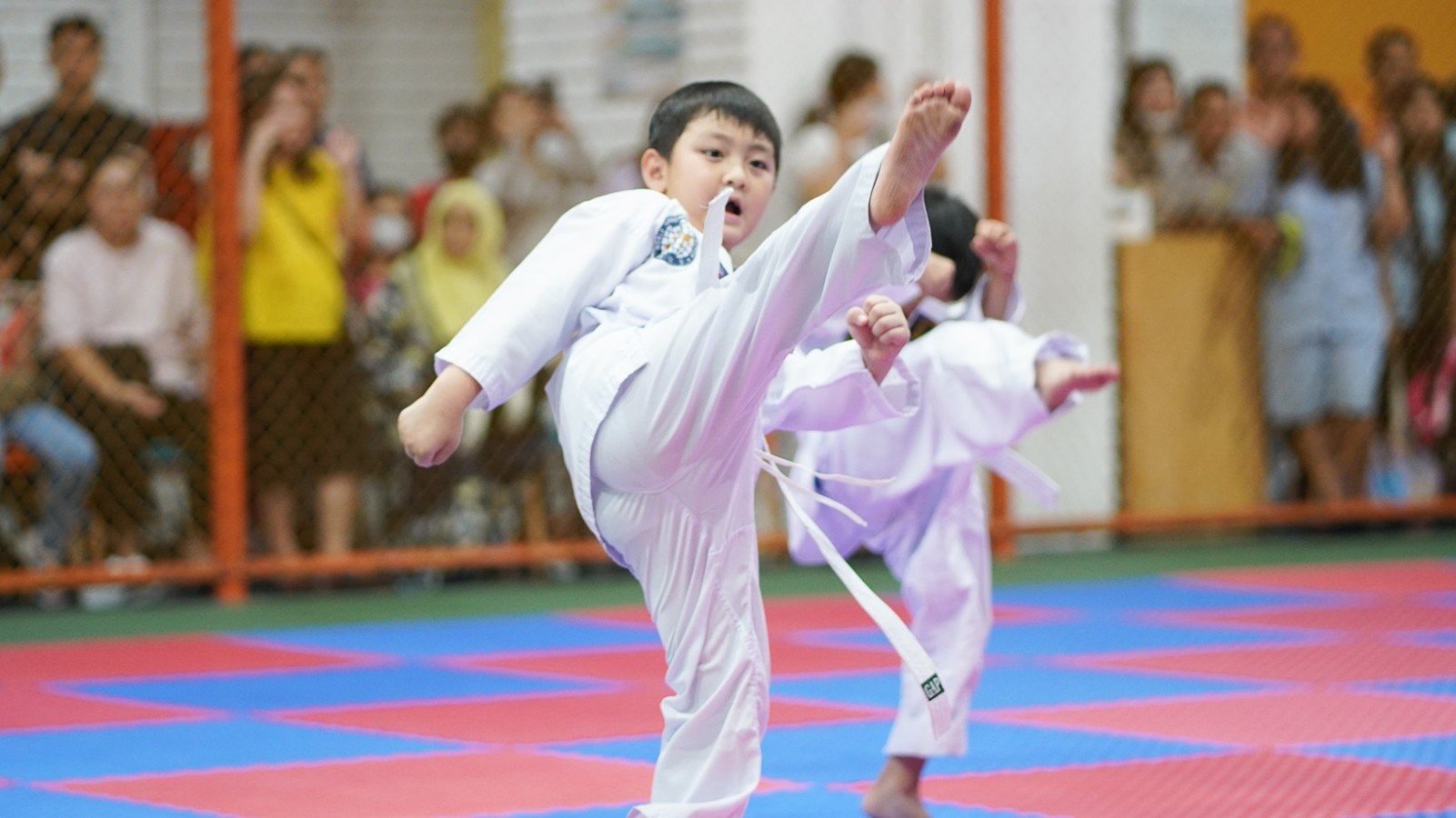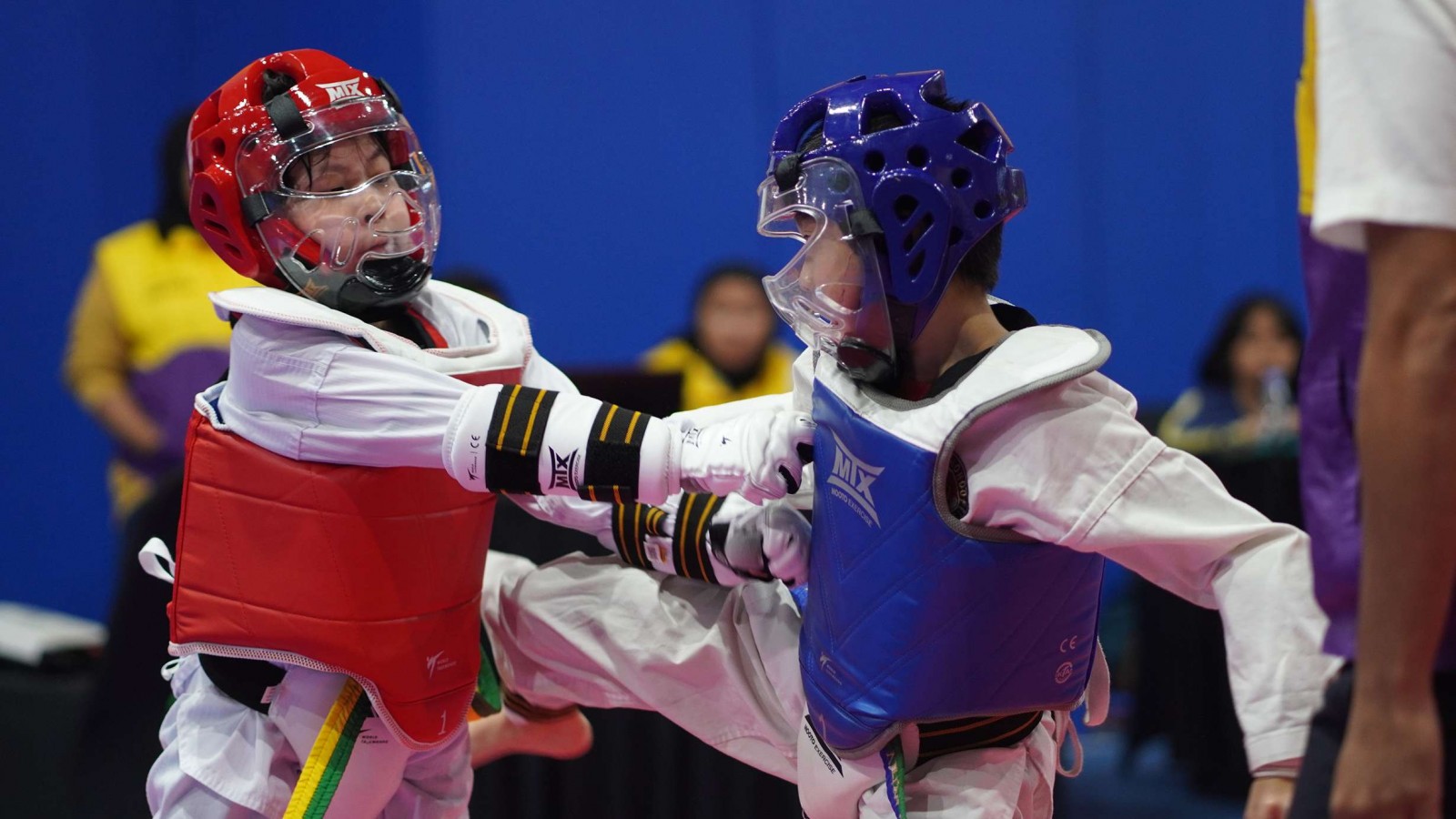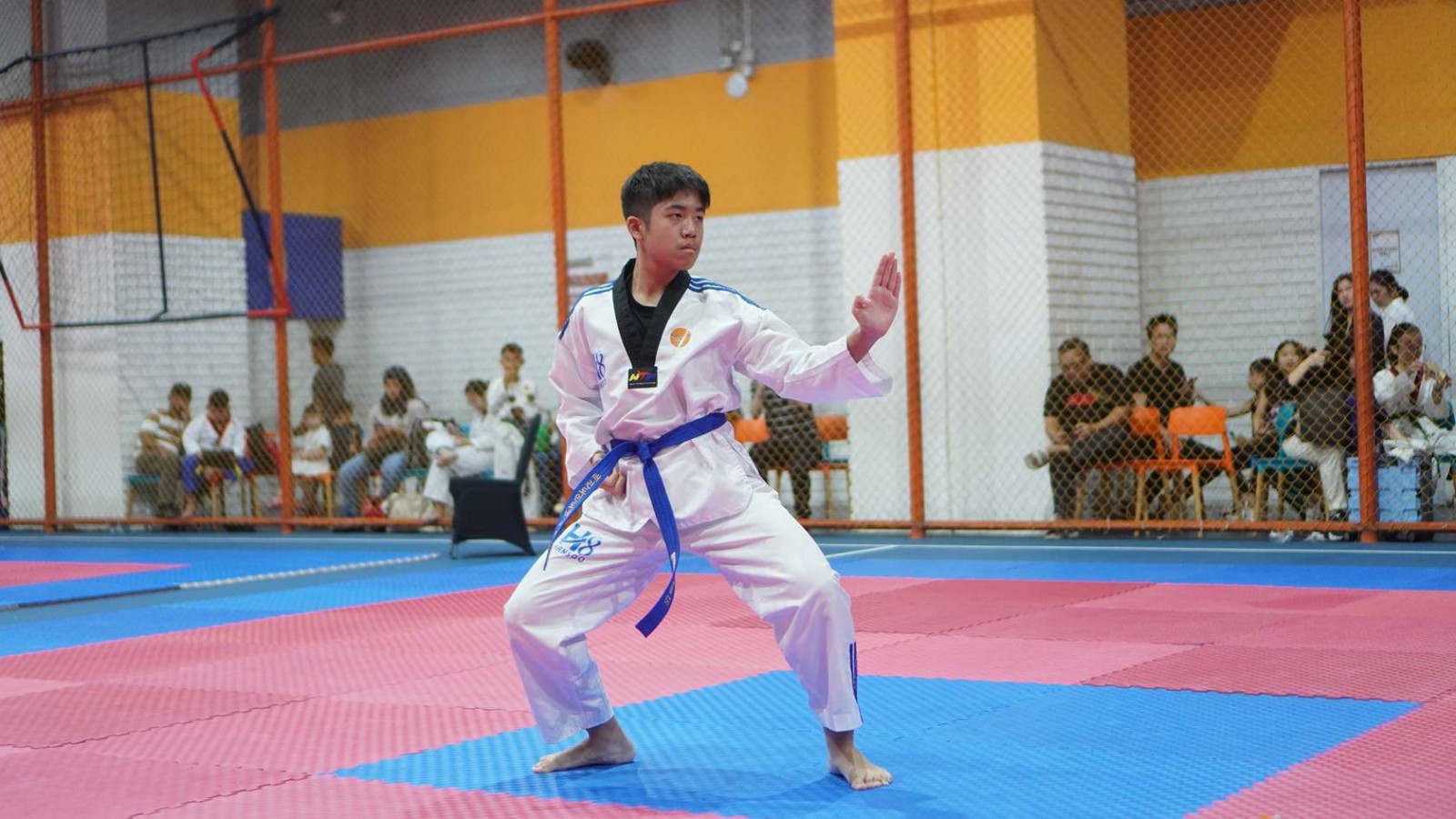Taekwondo Scoring: Areas, Penalties, and Knockdowns

Understanding Taekwondo scoring is essential to fully delve into the vibrant world of this martial art. Knowledge of the scoring system allows you to follow matches with greater insight and engage more deeply with the strategic elements that define Taekwondo.
This article delves into the intricacies of Taekwondo scoring, including the scoring areas, penalties, prohibited acts, key decisions, and knockdowns. Let’s break it down here!
Equipment and Facilities
Taekwondo is a combat sport that takes place between two fighters of the same weight category. The competition area is an octagonal-shaped space with an 8-meter diameter.
Competitors must wear a dobok, which is a white uniform, and are required to have additional protective gear. This includes a trunk protector, a head protector, and, for male athletes, a groin guard worn under the dobok.
Additionally, participants must be equipped with forearm and shin guards, gloves, sensing socks, and a mouth guard before entering the competition area. The head protector is typically carried under the left arm upon entering the competition area and is worn when instructed by the referee.
Full Explanation on Taekwondo Scoring Areas
In Taekwondo, points are awarded based on accurate and powerful strikes to specific target areas. These areas include the trunk (torso) and the head.
A. Trunk (Torso) Area
- Valid Target: The front and sides of the body, above the belt.
- Points Awarded:
- Body Kick: A clean kick to the trunk scores 2 points.
- Turning Body Kick: A spinning kick to the trunk earns 4 points.
Note: Punches to the trunk area are also scored but are worth 1 point, provided they are delivered with proper technique and sufficient force.
B. Head Area
- Valid Target: The entire head, including the face and sides.
- Points Awarded:
- Head Kick: A straightforward kick to the head scores 3 points.
- Turning Head Kick: A spinning kick to the head scores 5 points.
Note: Punches to the head are not permitted and result in penalties.
Prohibited Acts and Penalties
Penalties are a critical aspect of Taekwondo as they ensure the safety of competitors and the fairness of the match. Penalties are categorized into two types: Kyong-go (warning) and Gam-jeom (deduction).
Two 'Warnings (경고 Kyong-go)' result in one point being awarded to the opposing competitor. However, any final odd-numbered warning is not included in the total.
A Deduction Penalty (감점 Gam-jeom) grants one additional point to the opposing competitor. The following actions are considered prohibited and result in Warnings (경고 Kyong-go):
- Stepping outside the boundary line
- Avoiding or delaying the match
- Falling down
- Grabbing, holding, or pushing the opponent
- Attacking below the waist
- Butting or knee attacks (무릎 mu-reup)
- Hitting the opponent's face (얼굴 eolgul) with the hand
- Making undesirable remarks or any misconduct by a contestant or coach
- Raising the knee (무릎 mu-reup) to block a valid attack or hinder an opponent's progress
The following actions are also prohibited and result in Deduction Penalties (감점 gam-jeom):
- Attacking after the referee’s command of “Kal-yeo”
- Attacking a fallen opponent
- Throwing the opponent by grabbing or hooking their attacking foot or pushing with the hand
- Intentionally hitting the opponent's face with the hand
- A coach or contestant disrupting the match
- Violent or extreme behavior or remarks by a contestant or coach
- If using PSS (Protective Scoring System), before each round, the referee will check for any manipulation attempts. If found, the referee can issue a Deduction Penalty (감점 gam-jeom) and may declare the violator as the loser by penalty depending on the severity of the infraction.
If a contestant intentionally disregards the Competition Rules or the referee’s instructions, the referee may declare them the loser by punitive declaration after one minute.
If a contestant accumulates eight Warnings (경고 Kyong-go) or four Deduction Penalties (감점 gam-jeom), or a combination equating to minus four points, the referee will declare them the loser by penalties.
Warnings (경고 Kyong-go) and Deduction Penalties (감점 gam-jeom) are included in the total score across the three rounds.
When the referee pauses a match to issue Warnings (경고 Kyong-go) or Deduction Penalties (감점 gam-jeom), the match time is paused from the moment of the referee’s declaration of "Shi-gan" until "Kye-sok" is declared to resume the match.
Key Decisions
Referees play a vital role in Taekwondo matches, ensuring rules are followed and making crucial decisions. Here are some key decisions referees make:
1. Kal-yeo (Break)
This command is given to pause the match. The referee may use this to stop the match for safety reasons, to issue warnings, or to address other issues.
2. Kye-shi (Injury Time)
If a competitor is injured, the referee can call for Kye-shi, allowing up to one minute for the competitor to recover. If they cannot continue, the match may be decided based on the current score or the opponent may be declared the winner.
3. Shi-gan (Time)
The referee can pause the match to address time-related issues, such as resetting the clock or resolving equipment malfunctions.
4. Gam-jeom (Deduction)
As previously mentioned, the referee deducts points for significant rule infractions.
Knockdowns in Taekwondo Scoring
A knockdown in Taekwondo is a significant event that can shift the momentum of the match dramatically. It occurs when a competitor is knocked to the ground due to a valid strike and often resulting in a high score for the attacker.
Here are the criteria for knockdown in Taekwondo scoring:
- A knockdown is confirmed if the opponent is unable to rise within 10 seconds after being struck.
- The referee will count aloud, and if the downed competitor cannot continue, the match may end by a knockout (KO).
- While the act of knocking an opponent down doesn’t directly score additional points, the strike causing the knockdown often garners the highest possible points (such as a turning head kick scoring 5 points).
- If the competitor recovers within the 10-second count and wishes to continue, the match resumes. However, medical evaluations are often required to ensure safety.
Have You Understood About Taekwondo Scoring?
Understanding the taekwondo scoring system is essential for competitors and any taekwondo enthusiasts. By knowing the scoring areas and avoiding penalties, you can appreciate the intricacies of each match.
For parents whose children show an interest in Taekwondo, consider enrolling them in the martial arts program at Rockstar Academy. As the premier Sports & Performing Arts Academy, Rockstar Academy offers a variety of physical activity programs designed to develop your child's skills and potential.
Their curriculum includes the exciting Rock Olympics, providing students with an incredible learning experience to uncover their true capabilities. Additionally, their martial arts program offers Taekwondo Testing to help students progress to higher levels and prepare for both national and international competitions.
The best part? Rockstar Academy offers a free trial class for those interested in exploring Taekwondo. Our Taekwondo class offers specialized Taekwondo classes designed for children between the ages of 6 and 18.
So, if you're eager to see your child thrive in a dynamic and supportive environment, put on your dobok, tie your belt, and get ready to dive into the exciting world of Taekwondo with Rockstar Academy!
FAQ
Can punches score points in Taekwondo?
Yes, punches can score points but only to the trunk area. A properly executed punch to the body scores 1 point.
What happens if both competitors have the same score at the end of the match?
If the score is tied, the match can go into a sudden-death round called "Golden Point." The first competitor to score in this round wins. If no score is achieved, judges decide the winner based on the overall performance and dominance in the match.
Are there weight classes in Taekwondo competitions?
Yes, competitors are divided into different weight classes to ensure fair competition. Each class has specific weight limits for both males and females.
What is the duration of a Taekwondo match?
A standard Taekwondo match consists of three rounds, each lasting two minutes, with a one-minute break between rounds.
Can a competitor wear protective gear?
Yes, wearing protective gear is mandatory. This includes a headguard, trunk protector, forearm guards, shin guards, groin guard, and mouthguard to ensure the safety of the competitors.



